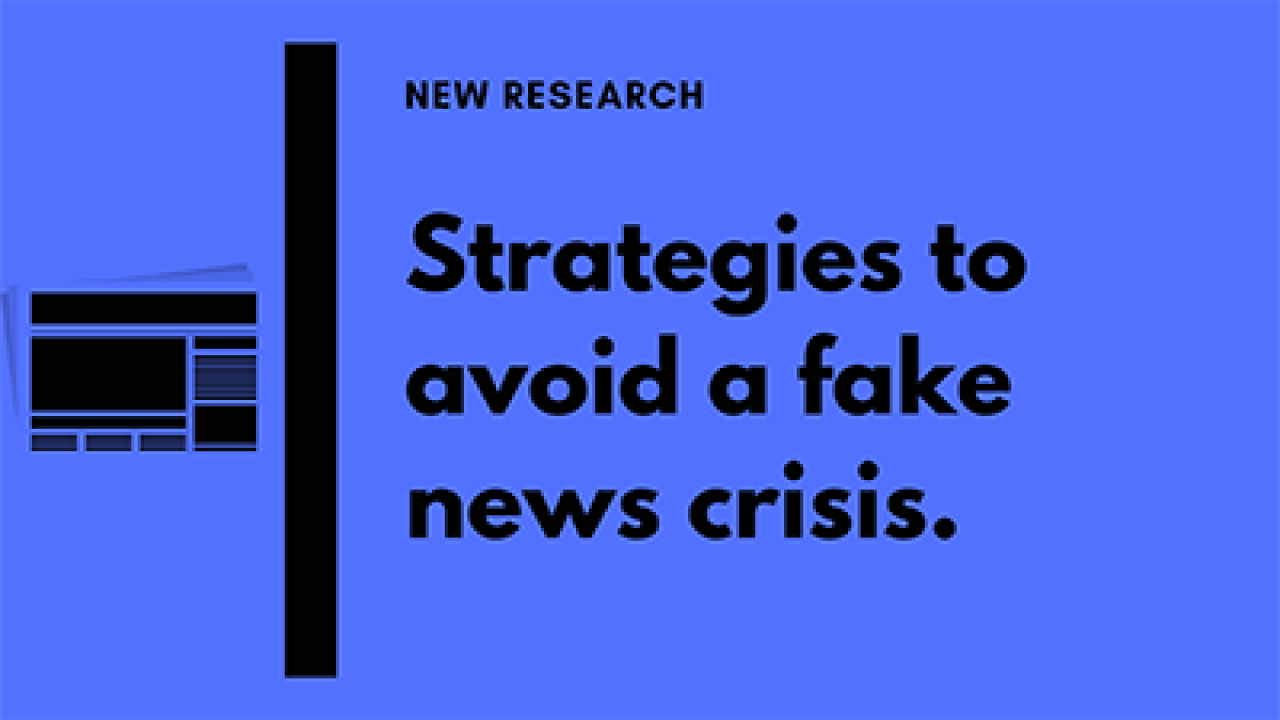June 05, 2019
How corporations can survive a fake news crisis

By Michele E. Ewing and Cheryl Ann Lambert, Kent State University
In a society where anything can be said and taken as fact by large segments of the population, organizations are facing an uphill battle to prove their communication is credible. Unfortunately, fake news producers have widened the gulf between what messaging organizations can and cannot control. To find out why some organizations have survived false accusations while others have not, we sought out senior corporate communication practitioners who have successfully navigated fake news and other crises.
These 21 senior corporate communications practitioners—12 from corporations and nine from agencies—offered insider perspectives that add substantially to what have thus far been news reports and case studies from outsider viewpoints. These practitioners use five specific strategies to avoid fake news crises:
Avoiding fake news crises
1. Listen online for emerging issues among multiple stakeholder publics
Through a variety of social listening tools, they monitor keywords for hot topics or triggers and sources connected to fake news scenarios. They also monitor spikes in sentiment (positive vs negative).
2. Use environmental scanning as an early-warning radar
By using this tried-and-true method, they gather intelligence about trends, issues, and other factors that can impact their company and/or industry.
3. Monitor influencers
Credible and authentic relationships with influencers help practitioners identify and minimize a fake news crisis. Internal and external influencers can set the record straight when inaccurate information is shared. They can also drive the narrative of traditional and social media news stories.
4. Plan for various scenarios
Crisis communication management typically involves a risk and crisis scenario assessment. When preparing for fake news-related crises, practitioners focus their threat scenarios on social conversations.
5. Minimize criticism through direct messaging.
With direct communication, practitioners can demonstrate transparency by addressing concerns or correcting false information in a public platform. They have to balance public and private responses to respect customer privacy and avoid igniting contentious social conversations. Since no organization is immune to fake news, interviewees offered five specific strategies to effectively manage crises originating from fake news:
Managing fake news crises
1. Listen, assess, and avoid fueling the fire
Practitioners analyze the scope of the issue, the volume and sentiment of conversations, and the credibility and reach of the sources. These practitioners alert the leadership team before deploying response strategies.
2. Engage people who are important to you.
It’s vital to connect with stakeholders to make them aware of the situation and share facts to address the false information. Employees and customers can play an important role in minimizing or fueling fake news. Practitioners stressed the importance of cultivating relationships before a crisis.
3. Paint a counter narrative rooted in facts through owned channels.
Use existing channels to communicate the organizational narrative. This approach connects back to sound channel planning strategies to reach audiences with credible content.
4. Address fake news within its space.
In a fake news environment, some situations may require a more direct approach with meeting the source of the false information where it’s being communicated to set the record straight. Factual information on owned channels should be easily found through search engine optimization. A proactive approach without a defensive tone is recommended.
5. Maintain relationships with news media.
It’s critical that the news media can quickly be directed to factual information sources to ensure journalists communicate accurate information and help stop the spread of false narrative. Media relations and social media strategies should be integrated for effective communication.
The more we understand best practices to prevent and manage fake news, the more we can safeguard honest and transparent communication and the ethical practice of public relations. Organizations rely on public relations practitioners to deliver timely, accurate messages. We are uniquely qualified to help them avoid reputational and monetary losses that far too often follow misinformation campaigns.
For more information about this project, please email Michele E. Ewing at meewing@kent.edu or Cheryl Ann Lambert at clambe17@kent.edu. This project was supported by a Page Legacy Scholar Grant from the Arthur W. Page Center.
